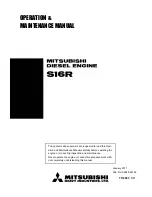
5.06 Drive Interface
5.07 Interface Hardware for Digital Control: Pin PWM* / E*
The Drive interface, i.e. the connections between the CCU (Custom Control Unit) and the Drive, is depicted
in the picture above.
The CCU electronics and the Drive electronics are connected via two unidirectional lines.
The PWM signal for the input PWM* / E* comes from the CCU electronics and uses a pull up resistor
(PWM* / E* pull up) located in the Drive electronics to determine the recessive level.
This pull up resistor is connected to the supply voltage plus: +D / UB.
The dominant level on the input PWM* / E* is low level, provided by the switching to ground stage depicted in above
figure. as a bipolar npn transistor in the CCU.
The input PWM* / E* is used to wake up the Drive from Quiescent current mode. Any PWM duty cycle that
guarantees a pulse going to the dominant level for more than Twakeup will wake up the Drive electronics.
Parameters
Min
Typical
Max
Unit
Denomination
PWM* / E* frequency range
50
100
500
Hz
f
PWM
1)
PWM* / E* duty cycle range
0
100
%
dc
min
...dc
max
PWM* / E* high level voltage
U
B
*0.65
V
U
PWMH
PWM* / E* low level voltage
U
B
*0.45
V
U
PWMl
PWM* / E* resolution
1
%
dc
resol
PWM* / E* accuracy
1
%
dca
ccu
PWM* / E* current
-10%
5.5
+10%
mA
l
PWM*
PWM* / E* leakage current
200
ų
A
l
PWM*
PWM* / E* wage up voltage
U
B
- 2V
V
U
PWMWU
PWM* / E* wake up pulse
150
ų
s
T
wakeup
PWM* pull up
4.7
k
Ω
1): for production line internal reasons there is a test mode implemented which is activated at a PWM
frequency range from 1400 Hz to 1600 Hz with dedicated duty cycles for various test modes.
The application must not use this frequency range!
5.08 Interface Hardware for Analog Control: PIN A
5.09 Software Functions
The Drive has different working modes related mainly to the Drive current consumption:
1. Quiescent current mode
2. Electronics active mode
3. Run mode
4. Failure mode
The Drive mode changes accordingly to the control input duty cycle on pin PWM* / E* and the voltage level
on analog input A.
No.
Drive Mode
Current Consumption
Drive Speed
1
Quiescent current mode
< 100
ų
A
0
2
Electronics active mode
< 40
ų
A
0
3
Run mode
depending on the requested speed
and on the load
depending on the PWM duty cycle
or the analog input voltage level
4
Failure mode
< 40
ų
A
depending on the failure
The Quiescent current mode is entered when the pin PWM* / E* is on 100 % duty cycle (recessive level).
The time to go into Quiescent current mode depends on the actual PWM base frequency and the number of
samples for the plausibility check (see chapter 12.3). Additionally 2 s are waited after the detection of the
absence of the PWM signal before finally going into Quiescent current mode.
The Electronics active mode is entered with any PWM duty cycle value between 0 % and < 100 % if the
condition from chapter 10 is fulfilled (Twakeup).
The Run mode is entered in the following cases:
- if the PWM duty cycle on pin PWM* / E* has a value where the Drive is asked to run (see p.11)
- if the analog signal on pin analog input A has a value where the Drive is asked to run (see p.12)
The Failure mode is entered in case of failures of the Drive (see p.12)
Parameters
Min
Typical
Max
Unit
Denomination
A voltage range
0
10
V
U
A
Absolute maximum A voltage
-32
35
V
U
Amax
A current range
0
0.32
mA
l
A
A maximum current
-1.8
1.8
mA
l
Amax
12
13
Parker Hannifin
Cylinder and Accumulator
Division Europe
Parker Hannifin
Cylinder and Accumulator
Division Europe
Manual and Installation Guide
Manual and Installation Guide
QDC
for electrified mobile applications
QDC
for electrified mobile applications






























